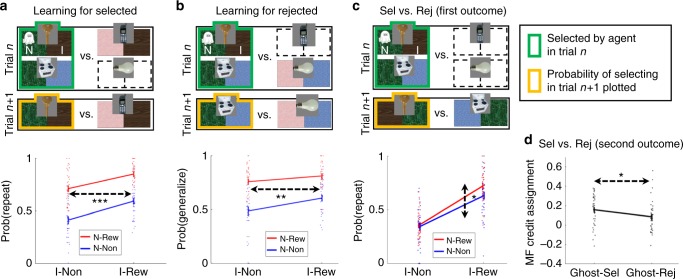Fig. 4.
MF Learning for ghost-nominated and ghost-rejected objects on uncertainty trials. a The probability of repeating a choice, i.e., select the trial-n ghost-nominated object, as a function of the previous-trial non-informative, “N” (here green), and informative, inference-allowing, “I” (here brown) outcomes (bottom). Only “repetition” standard trials that offered for choice the previously ghost-nominated object alongside the object from the previously non-chosen pair, which shared the previously informative outcome with the ghost-nominated object, were analysed. The main effect of the Informative outcome implies that credit from this outcome was assigned by a MF learner to the ghost-nominated object. b Similar to a, but here, the probability to generalize the choice, i.e., select the ghost-rejected object is shown. Only “switch” standard trials that offered for choice the previously ghost-rejected object alongside an object from the previously unchosen pair (the one that shares an outcome with the ghost-rejected object) were analysed. The main effect of the Informative (brown) outcome implies that credit from this outcome was assigned by MF to the ghost-rejected object. c Similar to a but only “clash” standard trials that offered for choice the previously ghost-nominated and rejected objects, i.e., the previously chosen pair, were analysed. The main effect of the non-Informative outcome (green) implies that credit from this first outcome was assigned by MF mainly to the ghost-nominated object. Each standard trial after an uncertain trial was either a repeat, switch or a clash trial and hence contributed to exactly one of the panels. d Comparing the main effects from the analyses in a and b shows that credit from the second informative, inference-allowing, outcome was assigned by MF mainly to the ghost-nominated object. Error bars correspond to SEM across-participants calculated separately in each condition, n = 40. Dotted arrows indicate the main effect of interest. *,** and *** denote p < 0.05, p < 0.01 and p < 0.001, respectively. In case no asterisks are presented, the effect of interest was not significant. In a–c p-values were calculated based on a mixed effects logistic regression models. In d, p-values were calculated based on a paired-sample t-test. Dots represent individual participant results. Images adapted from the stimulus set of Kiani et al. 2007, ref. 40

